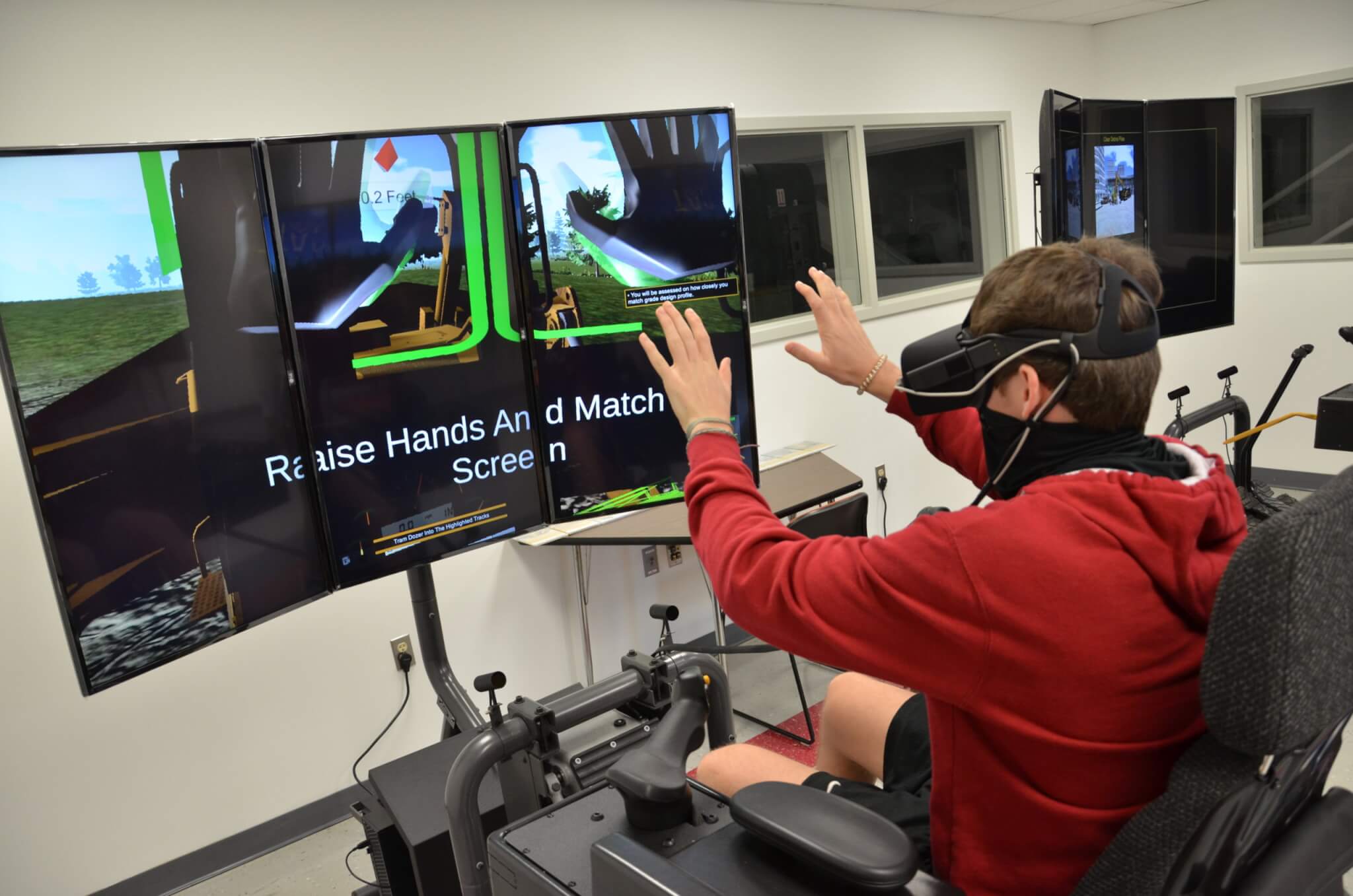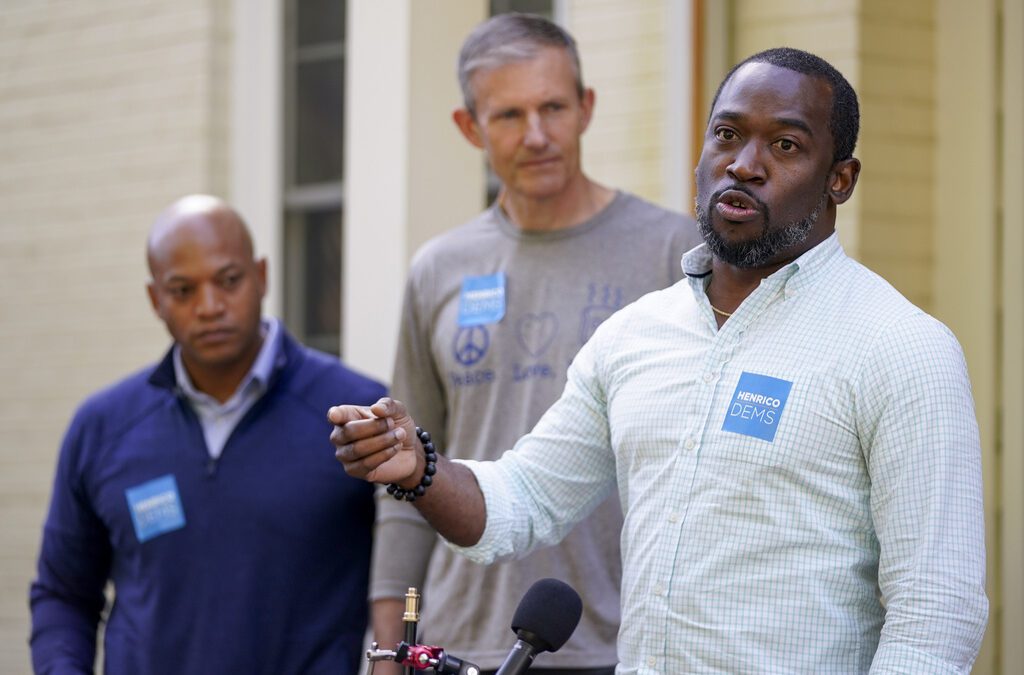
Mitchell Dunford, a Patrick Henry Community College General Engineering Technology student, tests out a new simulator the college recently purchased. Contributed photo.
General Assembly committee learns what the governor proposes for higher education in his latest amendments.
RICHMOND – The pandemic caused some financial problems for Virginia’s higher education system. The good news is that Gov. Ralph Northam has a plan to solve them. On Tuesday, members of the Virginia Higher Education Subcommittee learned how exactly he proposes doing that.
“As we all know, the 2021 year was one of enormous uncertainty in so many areas, including in higher education,” committee chair Sen. Mamie Locke said. “We are continuing to focus on coronavirus-specific issues, but also keep an eye toward ongoing work and issues that will continue, going forward.”
Sarah Herzog, committee staff, then took the screen, presenting an overview of Gov. Ralph Northam’s proposed amendments to the 2020-22 Biennial Budget in Higher Education.
The 753-page document outlines operating expenses, capital project expenses, miscellaneous items and general provisions.
The proposed amendments created a net change in the budget for the first year by $142.3 million and the second year by $32 million. That’s a 5.8% change from the previous budget and then a 1.4% change from 2021 to 2022.
The changes also reflected additional restorations of $111.2 million and new spending of $9.6 million.
Proposed Restorations to Higher Education
One of the main proposed restorations includes restoring the Virginia Community Colleges System’s (VCCS) 3-G Last Dollar plus Workforce Initiative. The program helps with the cost of tuition, fees and textbooks for low and middle income students in select high demand workforce pathways. It provides additional incentive for full-time Pell-eligible students. The proposed budget includes $36 million for the incentive.
Need-based financial aid and the Tuition Assistance Grant also made the list at $30.3 million and $7.9 million respectively.
Private and public colleges and universities also took a chunk of the change, totaling over $30 million.
Additional restorations for institutions between 2021 and 2022 summed up to $27.1 million. They included items like restoring the Massey Cancer Center at Virginia Commonwealth University, restoring Longwood University’s Early Childhood degree and various other actions.
Other proposed amendments, like the University of Virginia’s Focused Ultrasound Center, the VCCS’s Pre-Hire Immersion program and the New College Institute’s IT Integration position, made up a list of seven items totaling $9.6 million over the next two years.
Herzog also provided an update on federal relief. The new proposed budget adjusts the Coronavirus Relief Fund allocation for higher education to $116.3 million, including a VCCS allocation for the Re-employing Virginians (REV) program at $30 million.
“The new act has sort of a similar total amount for higher education, but differs in many ways,” Herzog said. “It will no be doubt be different by sector this time, as well as by institution, including they did more of a focus on headcount in terms of the distribution than [full-time equivalent] enrollment.”
RELATED: Why Didn’t Virginia’s Minimum Wage Go Up?
2021 Consolidated Appropriations Act
Peter Blake, executive director of the State Council of Higher Education for Virginia (SCHEV), also gave a preliminary overview of the 2021 Consolidated Appropriations Act.
The act is a 5,593-page document. The pages outline a $2.3 trillion spending bill. Out of that, $900 billion goes toward stimulus relief for the COVID-19 pandemic in the United States. A total of $1.4 trillion serves as an omnibus spending bill for the 2021 federal fiscal year. It also prevents a government shutdown.
“We do expect in the new funding, the Consolidated Appropriations Act, to be a little bit more than what we received through the CARES funding in the last act from 2020,” Blake said. “So a little bit of an increase, both in the version from last year and then the one that Congress just recently completed.”
He also speculated an increase in the Governor’s Emergency Education Relief Fund, with the majority heading toward private education.
A portion of the money grants aid directly to the students. It will cover a new program offering $50 monthly broadband vouchers for students receiving Pell grants who do not live in dormitories. It will also expand SNAP benefits for students receiving work-study or with a $0 Expected Family Contribution.
Compared to the CARES Act, which gave a grand total of $567,259,744 to public, private and for-provide institution, the Consolidated Appropriations Act proposed a grand total of $564,000,000. Out of the $564 million, there’s $488 million proposed for the Higher Education Emergency Relief Fund.
“These are all preliminary numbers. We don’t have the final allocations from the U.S. Department of Education yet,” Blake said. “These are estimates based on headcount enrollment and the methodology that’s laid out in the legislation. But we expect in Virginia $488 million dollars.”
Pandemic Impact on Higher Education
Blake also gave an update on 2020-21 school year operations, enrollment and other impacts of COVID-19.
In his presentation, he covered a decline in college attendance and occupancy rates. He also noted a push toward adjusted college schedules and hybrid offerings on campuses across the state.
Blake touched on the coming COVID-19 vaccine for college faculty members. He expressed that there was not a set date for that group.
One of the areas COVID-19 made a noticeable impact were the college campus tours, application and financial aid events. Numbers were down in the fall 2020 semester for each of the offerings.
“All the kinds of things that are most successful if you have one-on-one contact and personal relationships. Those had to be done online. And I think there’s a consequence to that,” Blake said.
In connection, FAFSA application rates also dropped.
“Particularly concerning is that the decreases are even greater in our Title I eligible high schools and in some high schools that have a high minority enrollment,” Blake said.
While Blake noted a strong foundation in America’s higher education system, he also expressed room for improvement.
“There continue to be some longer-term issues that will be outstanding,” Blake said.
The ongoing work Blake expressed included focusing on achievement gaps, operating costs and state investments, outreach to high school students and adults who have some colleges, a program and labor market alignment and digital access, adoption and literacy.
Amie Knowles reports for Dogwood. You can reach her at [email protected].
Politics

Biden administration bans noncompete clauses for workers
The Federal Trade Commission (FTC) voted on Tuesday to ban noncompete agreements—those pesky clauses that employers often force their workers to...

Democratic shakeup in Virginia primaries for governor, lieutenant governor
Richmond Mayor Levar Stoney quit his bid for governor and jumped into the race to be the Democratic nominee for lieutenant governor. The race for...
Local News

The zodiac signs of 12 iconic women offer insight into their historic accomplishments
Zodiac signs can tell you a lot about someone’s personality. Whether they’re an earth, water, air, or fire sign, these 12 categories (which are...

Virginia verses: Celebrating 5 poetic icons for National Poetry Month
There’s no shortage of great writers when it comes to our commonwealth. From the haunting verses of Edgar Allan Poe, who found solace in Richmond's...





